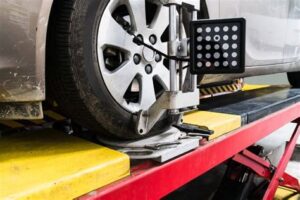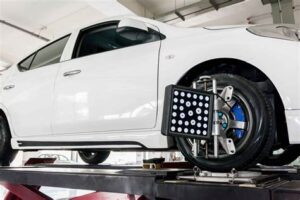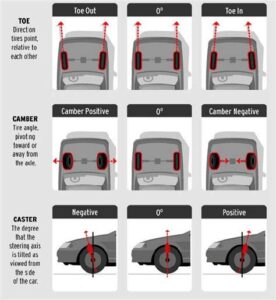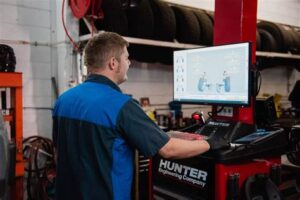Discover the causes, symptoms, effects, and preventative measures of car misalignment, and learn the importance of regular alignment checks for a smooth ride.Maintaining proper car alignment is crucial for ensuring a smooth and safe driving experience. However, it’s not uncommon for vehicles to suffer from misalignment due to various factors. In this blog post, we will explore the common causes of car alignment issues, such as hitting potholes or curbs, and the telltale symptoms that signal your vehicle might be out of line. We’ll also discuss the detrimental effects misalignment can have on your car’s performance and lifespan, as well as preventative measures you can take to avoid these problems in the first place. Lastly, we will highlight the importance of scheduling regular alignment checks to keep your car running efficiently and to enhance your overall driving safety. Join us as we dive into the world of car alignment and how to keep your vehicle in top shape.
Causes of Misaligned Car
Car alignment issues can arise from a variety of factors that affect the precision of your vehicle’s wheel positioning. One of the primary causes of misalignment is hitting a pothole or curb. Such sudden impacts can disrupt the arrangement of your wheels, leading to alignment problems.
Another significant cause is regular wear and tear on vehicle components. Over time, parts like the suspension system, wheel bearings, and tires can deteriorate, which might cause the wheels to shift away from their intended positions. The tire pressure can also significantly influence alignment; incorrect tire pressure can cause uneven tire wear, exacerbating alignment issues.
Additionally, any alterations made to your vehicle’s height – such as lifting or lowering – can lead to misalignment. These modifications, especially when done without proper adjustments, can throw the car’s geometry off. Routine maintenance and careful monitoring of your vehicle’s components are essential to prevent alignment issues and ensure a smooth driving experience.
Symptoms of Alignment Issues
Identifying symptoms of alignment issues in your vehicle is crucial to ensuring safe and efficient driving. Proper wheel alignment keeps your tires wearing evenly and your steering precise. Here are a few common signs that suggest your car may be experiencing alignment problems:
- Uneven Tire Wear: If you notice that your tires are wearing more on one side than the other, this is a clear indication of alignment issues.
- Pulling to One Side: If your car drifts to the left or right while you are driving on a straight road, it may be due to misalignment.
- Steering Wheel Off Center: A steering wheel that is not centered when driving straight can be a symptom of alignment problems.
- Increased Vibration: Excessive vibration in the steering wheel can indicate an alignment issue, and may also relate to uneven tire wear.
- Clicking or Grinding Noises: Unusual sounds when turning the steering wheel may also signify issues related to alignment.
Addressing these symptoms promptly can prevent further damage to your vehicle and improve your overall driving experience. Regularly monitoring your car’s performance can help you spot these issues early.
If you are experiencing any of these indications, it’s wise to consult with a professional mechanic who can conduct a proper wheel alignment check. Understanding and recognizing these symptoms of alignment issues can help yo
Effects of Misalignment on Car
When a car suffers from misalignment, the effects can be detrimental not only to the vehicle itself but also to the safety of its occupants. One of the most immediate impacts of misalignment is uneven tire wear. Tires can become worn out prematurely on one side, leading to the need for frequent replacements. This not only hurts your wallet but also compromises the vehicle’s performance.
Another significant effect of misalignment is compromised handling and stability. Drivers may notice that their car pulls to one side, making it difficult to drive straight. This constant pulling can lead to driver fatigue and an increased risk of accidents, particularly in adverse weather conditions. Proper alignment is essential for maintaining optimal handling characteristics.
Additionally, misalignment can place undue stress on the car’s suspension and steering components. Over time, this stress can contribute to more severe mechanical issues that require expensive repairs. Ignoring alignment problems can ultimately lead to a greater financial burden for car o
Preventative Measures for Alignment
Ensuring your vehicle maintains proper alignment is crucial for optimal performance and safety. There are several preventative measures you can take to keep your car’s alignment in check.
One of the most effective strategies is to have your tires rotated regularly. This practice helps ensure even wear on all tires, which can support better alignment. Additionally, make sure your tire pressure is always at the recommended level; both under-inflation and over-inflation can pull your vehicle out of alignment.
Another important measure is to be mindful of how you drive. Avoid potholes, curbs, and other road hazards, as these can cause immediate alignment issues. It’s also beneficial to take notice of your car’s handling and steering; if you feel any pulling or drifting, it’s a sign to check the alignment. Finally, consider scheduling regular professional alignment checks with a trusted mechanic to proactively address any issues before they escalate.
Importance of Regular Alignment Checks
Maintaining proper car alignment is crucial for the performance and safety of your vehicle. Regular alignment checks can prevent a cascade of issues that may arise from neglecting this aspect of car maintenance. Here’s why these checks are important:
Firstly, alignment issues can lead to uneven tire wear, reducing the lifespan of your tires significantly. An investment in regular alignment checks helps ensure that you get the full value out of your tires, as well as maintain optimal fuel efficiency. When tires wear unevenly, not only do you have to replace them more often, but your vehicle also consumes more fuel due to the increased resistance.
Secondly, misalignment can adversely affect your vehicle’s handling. This may lead to a decrease in steering responsiveness or cause the vehicle to pull to one side, which can be dangerous when driving at higher speeds. Regular alignment checks enhance your car’s stability, ensuring a safer ride for you and your passengers.
Lastly, alignment checks can be an excellent opportunity to check other essential components of your vehicle. Professionals often inspect your suspension system and tires during these checks, which helps catch potential problems early. This proactive approach not only saves money in the long run but also ensures that your vehicle operates efficiently and safely.
Frequently Asked Questions
What is car alignment?
Car alignment refers to the adjustment of a vehicle’s suspension system, ensuring that the wheels are positioned correctly in relation to the road and each other.
What causes car alignment issues?
Car alignment can be messed up by various factors such as hitting potholes, curbs, or speed bumps, as well as worn-out suspension components and uneven tire pressure.
What are the signs of misalignment?
Signs of misalignment include uneven tire wear, your vehicle pulling to one side while driving, a crooked steering wheel, and vibrations while driving.
How often should I check my car’s alignment?
It’s recommended to check your car’s alignment every 6,000 miles or whenever you replace tires, experience a rough ride, or notice any alignment symptoms.
Can misalignment affect fuel efficiency?
Yes, misalignment can lead to increased rolling resistance on your tires, causing your vehicle to work harder and thus reducing fuel efficiency.
Is car alignment something I can do myself?
While some basic checks like visual inspections can be done at home, proper car alignment requires specialized equipment and should be performed by a professional mechanic.
Are there any preventive measures to maintain alignment?
Preventive measures include regular tire rotations, maintaining proper tire pressure, and avoiding hitting potholes or curbs whenever possible.





